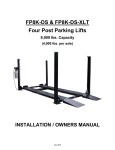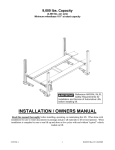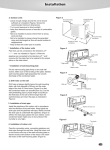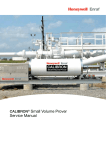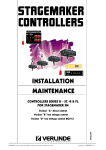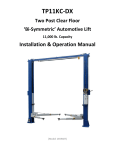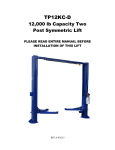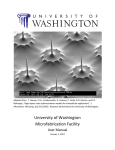Download pro 11000acd 2 post lift user manual
Transcript
165948 Two Post Lift Installation and Owners Manual 11. Keep the area around the lift clear of obstacles. 12. Never override the self-returning lift controls. 13. Use safety stands when removing or installing heavy vehicle components. 14. Avoid excessive rocking of the vehicle when it is on the lift. 15. To reduce the risk of personal injury, keep hair, loose clothing, fingers, and all body parts away from moving parts. 16. To reduce the risk of electric shock, do not use the lift when wet, do not expose the lift to rain. 17. To reduce the risk of fire, do not operate equipment in the vicinity of open containers of flammable liquids (gasoline). 18. Use the lift only as described in this manual, use only manufacturer’s recommended attachments. 19. Unusual vehicles, such as limousines, RV’s, and long wheelbase vehicles, may not be suitable for lifting on this equipment. If necessary, consult with the manufacturer or the manufacturer’s representative. 20. The troubleshooting and maintenance procedures described in this manual can be done by the lift’s owner/employer. Any other procedure should only be performed by trained lift service personnel. These restricted procedures include, but are not limited to, the following: cylinder replacement, carriage and safety latch replacement, leg replacement, overhead structure replacement. 21. Anyone who will be in the vicinity of the lift when it is in use should familiarize themselves with following Caution, Warning, and Safety related decals supplied with this lift, and replace them if the are illegible or missing. Monthly Maintenance: 1. Lubricate the four inside corners of the legs with heavy duty bearing grease. 2. With lift lowered check the hydraulic fluid level. If necessary add oil as described in the Installation Instruction section of this manual 3. Check carriage latch synching: Latches should click at the same time. If necessary adjust equalization cables as described in the Installation Instruction section of this manual. 4 165948 Two Post Lift Installation and Owners Manual 4. Check tightness of all bolts. 5. Check anchor bolt tightness. If the anchor bolts are loose, they should be re-torqued to 90ft/lbs. Check the nuts for tightness every week for the first month, and every month afterwards. 6. Replace worn or broken parts with lift manufacturer’s parts, or their equivalent. Troubleshooting: 1. The power unit does not run: a. Check electrical supply breaker, or fuse. b. Check for activation of the travel limit switch by a tall vehicle. c. Check micro-switch and connections in motor control box. d. Check voltage to the motor. e. Check micro-switch and connections in the overhead switch box. 2. The power unit runs but does not raise the lift: a. Check the oil level. b. Check that the lowering valve is not stuck open. c. Check the connections and components on the suction side of the pump. 3. The power unit raises the lift empty, but will not lift a vehicle: a. Make sure the vehicle is not above the rated capacity of the lift. b. Make sure the vehicle is positioned properly. c. Clean the lowering valve by running the power unit for 30 seconds while holding the lowering valve open. d. Check the motor voltage. 4. Lift drifts down: a. Check for external leaks. b. Clean the lowering valve by running the power unit for 30 seconds while holding the lowering valve open. Repeat this procedure three times. c. Clean the check valve seat. 5. Slow Lifting and/or oil foaming up: a. Check that oil used meets the specification in the Installation Instruction section of this 5 165948 Two Post Lift Installation and Owners Manual manual. b. Tighten all suction line fittings. 6. Anchors continually work loose: a. If holes were drilled too large relocate the lift per the Installation Instruction section of this manual. b. Floor is not sufficient to provide the necessary resistance, remove an area of concrete and repour as described in the Installation Instruction section of this manual. 7. Lift does not raise and lower smoothly: a. Reposition vehicle for a more even weight distribution. b. Check the four inside corners of the two legs for roughness. Any rust or burrs must be removed with 120 grit emery cloth. c. Lubricate the leg corners with heavy duty bearing grease. d. Use a level to check the legs for vertical alignment both side to side and front to back. Shim the legs as necessary per the Installation Instruction section of this manual. e. Check the oil level. f. Make sure there is no air in the hydraulic lines, bleed system as described in the Installation Instruction section of this manual. 8. The lift will only lower approximately 1”, then stops: a. Check that the safety latch pull rods are disengaged. If after disengagement of the pull rods, one of them moves back up as the lift is lowered, the pull rod is out of adjustment and is rubbing on the leg. Adjusting the rod to clear the leg. Push down on the first bend of the rod just inside the leg. Bend the rod slightly to allow it to move freely between the leg and the carriage. 6 165948 Two Post Lift Installation and Owners Manual 10. Power Unit will not stop running: a. Switch is damaged, Turn off power to the lift and replace switch. Section 2 Installation Instruction Tools requires for installation: Concrete hammer drill with 3/4” bit 11/16” open end wrench 3/4” open end wrench Torque wrench 15/16” deep socket or wrench 1-1/8” socket 13/16” open end wrench Level (18” minimum length) Vise grips Tape measure Funnel Hoist or Forklift (optional) Two 12’ step ladders 1/4” drive ratchet with 5/16” socket Procedure: 8 165948 Two Post Lift Installation and Owners Manual 1. Read this manual thoroughly before installing, operating, or maintaining this lift. 2. Site Evaluation and Lift Location: A. Always use an architect’s plan when provided. Before unpacking the lift entirely, determine if the site is adequate for the lift model being installed see figures 2 and 3 for typical bay layout and ceiling height requirements. B. Snap chalk lines to identify the lift’s centerline. C. Snap a chalk line parallel to the lift’s centerline, spaced 9” toward the rear of the bay. This line represents the back edge of the leg bases. D. Snap chalk lines parallel to the lift’s centerline spaces 68-1/2 to the left and 68-1/2 to the right. These lines represent the APPROXINMATE outside edges of the leg bases. DO NOT USE THESE LINES TO POSITION THE LEGS, FOLLOW THE INSTRUCTIONS IN THIS MANUAL. 9 165948 Two Post Lift Installation and Owners Manual 3. Unpack the lift. Remove the swing arms, bolt box, power unit box, and overhead beam. A. Save all packing hardware, as these components are necessary to complete the installation. B. Remove the ½” bolts from the uprights which hold the two legs together. C. Remove the top leg. Do not stand legs up, instead lay the legs flat their backs on the floor. 4. Attach the cylinder mount or uprights. Attach the cylinder mounts or uprights to the legs using four ½” X 1-¾” bolts, washers and nuts as shown in figure 4. 10 165948 Two Post Lift Installation and Owners Manual Figure 4 5. Install hydraulic cylinders, fittings, hoses, and cables. A. Warning: When attaching hydraulic fittings with pipe threads to the cylinders use Teflon tape. DO NOT start the Teflon tape closer than 1/8” from the end of the fitting. Failure to comply may cause damage to the Hydraulic system. B. Warning: When tightening connections with flared (JIC) fittings, always follow the following tightening instructions. Failure to follow these instructions may result in cracked fitting and/or leaks. Use the proper size wrench. ↓ The nut portion of the fitting is the only part that should turn during tightening. The flare seat MUST NOT turn. ↓ Screw the fittings together hand tight. ↓ Use the proper wrench to rotate the nut portion of the fitting 2-1/2 hex flats. ↓ Back the fitting off one full turn. ↓ Again, tighten the fitting hand tight, then rotate the nut portion of the fitting 2-1/2 hex flats. C. Connect the hydraulic bushings and ¼ push-in return line connectors to the return port of each cylinder. 11 165948 Two Post Lift Installation and Owners Manual G. Connect the remaining hydraulic hose to the branch on the JIC tee fitting. H. Install the rubber grommet into the hole in the mainside leg. I. Connect a male pipe thread to male JIC elbow to the port near the rod end of each cylinder. The fittings should face away from the leg’s baseplate. J. Connect the free end of the shortest hydraulic hose to the elbow on the cylinder in the mainside leg. This connection should be hand-tight only. K. Feed the shortest remaining hose through the rubber grommet, from inside the leg out. Feed this hose down through the hose guide welded to the outside of the leg. This hose will attach to the power unit. L. Feed the long hose through the cylinder mount or upright tube along the cylinder and out the end, M. Feed one end of an equalization cable down through the rightmost hole in the carriage top, figure 6. Continue to feed the cable until it extends out the bottom of the carriage. Attach a nylon insert locknut and washer to the end of the cable so that 1/8” of cable stud extends past the end of nut. Pull the opposite end of the cable until the washer contacts the carriage top. Repeat for the other cable/carriage. Figure 6 N. Attach the cylinders to the carriages. Make sure the snap ring on the cylinder rod is in the groove. Taking care not to damage the threads on the cylinder rod, pull carriage up to the cylinder and feed the rod through the hole in the carriage plate until the snap ring contacts it. Attach the full nut to the rod and tighten until the cylinder rod turns. 13 165948 Two Post Lift Installation and Owners Manual psi. D. Using the leg as a template, drill the anchor bolt holes for the Mainside leg Only!! Use a hammer drill with a Carbide tip, 3/4” diameter, solid drill bit. The bit tip diameter should be to ANSI Standard B95.12-1977. (.775” to .787”) ↓ Keep the drill perpendicular to the floor while drilling. ↓ Let the drill do the work. Do not apply excessive pressure. ↓ Lift the drill up and down to remove dust and reduce binding. ↓ Drill the hole completely through the slab. ↓ Clean the dust from the hole. E. Assemble the washers and nuts onto the anchor bolts. Thread the nuts onto the anchor bolts where the tops of the nuts are just above the top of the bolts, figure 8. Using a hammer, carefully tap the anchor bolts into the concrete until the washer rests against the baseplate. Do not damage the nuts or threads. F. Using a level, plumb the mainside leg both side to side and front to back. Shim the leg as 15 165948 Two Post Lift Installation and Owners Manual A. Single Phase Instructions, for 3-Phase instruction see 3-Phase kit. Using (2) ¼-20 X 1/2 HHCS and (2) ¼-20 Flange Lock Nuts attach the overhead switch assembly to the overhead beam as shown in figure 10. ↓ Slide the end of the padded switchbar without a mounting hole in it through the slot in the overhead switch assembly. Connect the padded switchbar to the inside hole in the overhead beam using a cylindrical spacer, ¼-20 X 1-3/4 HHCS, and Flange Nut, figure 11. B. Attach the overhead beam to the cylinder mounts or uprights. 17 165948 Two Post Lift Installation and Owners Manual Raise the overhead beam and secure it to cylinder mount or upright using two 1/2 x 1-3/4 bolts, washers and nuts on each end, Figure 11. 9. Anchoring offside leg. A. Using a level check the alignment and plumbness of the entire structure. Plumb the offside leg both side to side and front to back. B. The base of the leg may vary from the preliminary layout, as it is more important that the leg be perpendicular to the floor and parallel to the other leg. C. Install the anchor bolts and shim the base as described in the earlier “Leg positioning and anchoring” step. 10. Routing carriage equalization cables and offside hose, Figure 12. 18 165948 Two Post Lift Installation and Owners Manual around the sheave on the uprights, (while in the elevated position feed the offside hose through the hose guides welded to the top of the overhead tube and down through the offside upright tube.) ↓ feed cable through the clearance hole in the left hand corner of the carriage top, ↓ around the sheave at the bottom of the leg, ↓ through the hole in the center of the carriage top. C. Secure the cable end to the carriage top with a nylon insert nut and washer. Do not tighten the cable at this time. D. Repeat the process for the other cable, taking care not to cross them. E. Take out the slack, but do not tighten, in both cables by turning down the nuts on the top of each carriage top. Use vise grips to hold the cable end, but be very careful not to damage the threads. F. The carriages must remain at the same lock position while the cables are being tightened. Overtightening of one cable could raise the carriage in the opposite leg and cause the carriage safety latches to be out of sync. G. Alternately tighten the cable nuts at both carriages until the cables are tightened. Correct tension in the cables is indicated by being able to pull the cables together with 20 165948 Two Post Lift Installation and Owners Manual F. Any excess hose should be taken up in the uprights, or at the corners between the uprights and overhead. G. Add fluid. Remove the fill level screw near the top of the power unit tank. Remove the fill-cap from the tank and fill with Dexron III ATF or hydraulic oil that meets ISO-32, until fluid reaches the bottom of the screw hole. Replace the fill screw and tank breather. 13. Electrical. A. Single Phase Instructions, for 3-Phase see the 3-Phase kit. Have a certified electrician establish 208-230V, single phase, 60Hz., 20 amp, power supply to motor and overhead switch, figure 15. ↓ Use separate circuits for each lift. ↓ Single phase motor cannot be run on 50 Hz. line without modifications in the motor. 22 165948 Two Post Lift Installation and Owners Manual Red Wire Black Wire Blue Wire White Wire Green Wire Red Wire Figure 15 14. Bleeding the hydraulic system, figure 4. A. Loosen the connections between the hoses and fittings attached to the cylinders. Do not loosen the connections between the fittings and the cylinders themselves. B. Run the power unit until fluid appears at the mainside cylinder port. Tighten that hose connection. C. Run the power unit until fluid appears at the offside cylinder port and there is no more air. Tighten that hose connection. D. Lower the lift to the ground. If the lift is on the safety latches, raise the lift enough to disengage the latches and then lower. E. If the carriages were on the ground when the bleeding process was begun, no further bleeding is required. If not, repeat the previous steps for bleeding the hydraulic system. F. Add fluid to the system as previously described. 23 165948 Two Post Lift Installation and Owners Manual C. Raise the lift to full height. Lower the lift onto the safety latches. Raise the carriages, pull out both latch pull rods, and lower the lift to the ground. D. Raise the lift empty to the top of its travel and lower it to the floor three (3) times to remove the remaining air from the hydraulic system. E. The latches should click together as the lift is being raised. F. When the carriages are lowered onto the locks, neither pull rod should be capable of being pulled out. G. The first time a vehicle is placed on the lift, raise it no higher than three feet. Lower the vehicle onto the safety latches. Raise the lift a few inches and pull out both latch pull rods then lower the vehicle to the floor. H. Raise the vehicle to full height and lower the carriages onto the safety latches. Lower the vehicle to the floor. I. After cycling the lift ten times with a vehicle on it, recheck the tightness of the anchors to at least 90 ft-lbs. 25 Section 3 – Parts Breakdown NO Parts Code Description Qty OFFSIDE COLUMN Remark 1 TP11KACD-001 2 TP11KACD-002 SHORT HEIGHT ADAPTER 4 3 TP11KACD-003 MEDIUM HEIGHT ADAPTER 4 4 TP11KACD-004 LONG HEIGHT ADAPTER 5 TP11KACD-005 6 TP11KACD-006 7 TP11KACD-007 8 TP11KACD-008 HYDRAULIC CYLINDER 2 9 TP11KACD-009 ELBOW FITTING 2 10 TP11KACD-010 11 TP11KACD-011 HALF MOON GEAR 12 TP11KACD-012 SWING ARMS 2 1 each for left & right 13 TP11KACD-013 M6 LOCKNUT 8 M6 14 TP11KACD-014 #6 FLAT WASHER 8 φ6 15 TP11KACD-015 SWIVEL PAD 4 16 TP11KACD-016 RUBBER PAD 4 17 TP11KACD-017 18 TP11KACD-018 19 TP11KACD019 20 21 22 TP11KACD-022 23 TP11KACD-023 24 TP11KACD-024 25 1 4 REAR SWING ARMS 2 JAM NUT 2 CYLINDER NUT M10 x 40 BOLT ELEVATOR BOLT SWING ARM PIN 2 8 8 4 2 TP11KACD-020 E-CLIP 2 TP11KACD-021 SPACER 4 M14 NUT M10*40 4 FRONT SWING ARM SLIDER ELBOW FITTING (PUSH CONNECT) 1 each for left & right M14 1 12 M14 FLAT WASHER #14 28 φ14 TP11KACD-025 E-CLIP 10 φ15 26 TP11KACD-026 CABLE SHEAVE 27 TP11KACD-027 CABLE 28 TP11KACD-028 29 TP11KACD-029 OVERHEAD 1 30 TP11KACD-030 M14 x 45 BOLT 12 M14*45 31 TP11KACD-031 1 M8*40 32 TP11KACD-032 FLAT WASHER #8 14 φ8 33 TP11KACD-033 RETURN LINE 1 34 TP11KACD-034 FOAM PADDING 1 35 TP11KACD-035 36 TP11KACD-036 37 TP11KACD-037 SHUT 38 TP11KACD-038 T-FITTING 39 TP11KACD-039 40 TP11KACD-040 41 TP11KACD-041 42 TP11KACD-042 SHAFT SHEAVE CYLINDER PIN M8 x 40 BOLT BUSHING M8 M6 x LOCKNUT OFF 2 6 2 2 3 BAR 1 (PUSH TO CONNECT) 1 SCREW 4 10 OUTER SWITCH HOUSING OVERHEAD SWITCH TOP PLATE 26 M14*110 1 1 2 M8 M6*8 165948 Two Post Lift Installation and Owners Manual 43 TP11KACD-043 RETURN LINE 1 44 TP11KACD-044 MAINSIDE COLUMN 1 45 TP11KACD-045 RUBBER GROMMET 1 46 TP11KACD-046 LONG HOSE (207") 1 47 TP11KACD-047 T-FITTING 1 48 TP11KACD-048 MEDIUM HOSE (70") 1 49 TP11KACD-049 SHORT HOSE (54.5") 1 50 TP11KACD-050 CARRIAGE 2 51 TP11KACD-051 RUB BLOCK 16 LATCH 52 TP11KACD-052 53 TP11KACD-053 54 TP11KACD-054 55 TP11KACD-055 56 TP11KACD-056 57 TP11KACD-057 58 TP11KACD-058 59 TP11KACD-059 60 TP11KACD-060 LATCH RELEASE SPRING 2 61 TP11KACD-061 LATCH RELEASE ROD 2 62 TP11KACD-062 ROLL PIN 4 63 TP11KACD-063 ACTUATOR GEAR 4 64 TP11KACD-064 ACTUATOR PIN 4 65 TP11KACD-065 66 TP11KACD-066 CABLE NUT 4 M16 67 TP11KACD-067 FLAT WASHER #16 4 φ16 68 TP11KACD-068 33'8" EQUALIZER CABLE 2 69 TP11KACD-069 REAR SWING ARM SLIDER 2 70 TP11KACD-070 COTTER PIN 4 φ10 71 TP11KACD-071 M10 X 25 BOLT 4 M10*16 72 TP11KACD-072 73 TP11KACD-073 ANCHOR BOLT 74 TP11KACD-074 PU ELBOW FITTING 75 TP11KACD-075 O-RING 76 TP11KACD-076 FLAT WASHER #8 4 77 TP11KACD-077 M8 LOCKNUT 4 78 TP11KACD-078 M8 X 25 BOLT 1 79 TP11KACD-079 INNER SWITCH HOUSING 4 1 FLAT WASHER 2 φ30 LOCKNUT 2 M30 2 φ5 COTTER PIN 2 φ2*12 E-CLIP 2 φ9 FLAT WASHER #10 6 φ10 FLAT WASHER #6 LATCH RELEASE ACTUATOR PIN SPRING SHIM 2 φ6*38 4 16 27 12 3/4*140 1 1 φ11.8*φ1.8 M8 M8*25 165948 Two Post Lift Installation and Owners Manual 28 IMPORTANT POWER UNIT PRIMING PROCEDURE THE PROBLEM: Power unit runs fine but will not pump any fluid. Step 1 – Locate the check valve, the flush plug to the left of the lowering valve. (See drawing below.) Step 2 – Using an Allen wrench and shop towel – with shop towel in place to catch fluid – loosen the check valve plug 2 ½ turns to allow it to leak. Step 3 – Push the START button for one second, then release for three seconds. Repeat these steps until unit starts pumping fluid. Step 4 – Tighten the check valve plug. YOUR POWER UNIT SHOULD BE PRIMED

































